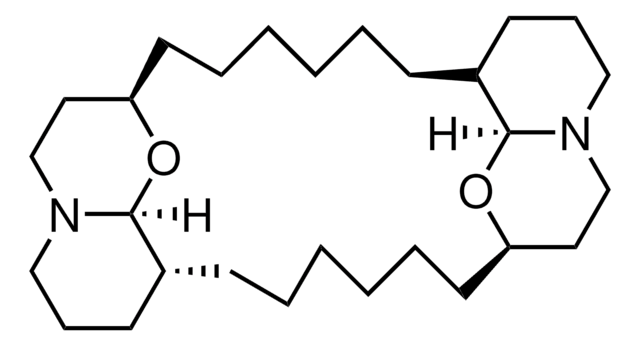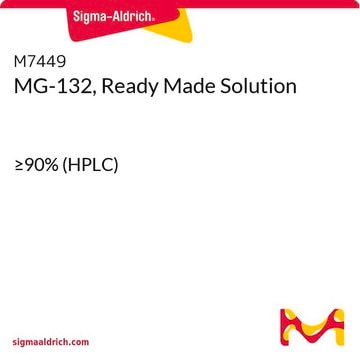239805
Cyclopiazonic Acid, Penicillium cyclopium
A cell-permeable, reversible inhibitor of sarcoplasmic reticulum Ca2+-ATPase that releases Ca2+ from the same intracellular pools as Thapsigargin.
Sinonimo/i:
Cyclopiazonic Acid, Penicillium cyclopium, CPA
About This Item
Prodotti consigliati
Livello qualitativo
Saggio
≥97% (TLC)
Stato
solid
Produttore/marchio commerciale
Calbiochem®
Condizioni di stoccaggio
OK to freeze
Colore
off-white
Solubilità
DMSO: 1 mg/mL
chloroform: 10 mg/mL
Condizioni di spedizione
ambient
Temperatura di conservazione
−20°C
InChI
1S/C20H20N2O3/c1-9(23)14-18(24)17-16-11-8-21-13-6-4-5-10(15(11)13)7-12(16)20(2,3)22(17)19(14)25/h4-6,8,12,16-17,21,25H,7H2,1-3H3/t12-,16+,17+/m1/s1
RLOAZVAJNNPPDI-DQYPLSBCSA-N
Descrizione generale
Azioni biochim/fisiol
Ca2+ uptake in cultured arterial musclue cells
Attenzione
Ricostituzione
Altre note
Elmoselli, A.B., et al. 1995. Mol. Cell. Biochem. 151, 149.
Schaefer, A., et al. 1994. J. Biol. Chem.269, 8786.
Demaurex, N., et al. 1992. J. Biol. Chem.267, 2318.
Low, A.M., et al. 1992. Am. J. Physiol.262, H31.
Kurebayashi, N., and Ogawa, Y. 1991. J. Muscle Res. Cell Motil.12, 355.
Mason, M.J., et al. 1991. J. Biol. Chem.266, 20856.
Note legali
Avvertenze
Danger
Indicazioni di pericolo
Consigli di prudenza
Classi di pericolo
Acute Tox. 2 Oral
Codice della classe di stoccaggio
6.1A - Combustible acute toxic Cat. 1 and 2 / very toxic hazardous materials
Classe di pericolosità dell'acqua (WGK)
WGK 3
Punto d’infiammabilità (°F)
Not applicable
Punto d’infiammabilità (°C)
Not applicable
Certificati d'analisi (COA)
Cerca il Certificati d'analisi (COA) digitando il numero di lotto/batch corrispondente. I numeri di lotto o di batch sono stampati sull'etichetta dei prodotti dopo la parola ‘Lotto’ o ‘Batch’.
Possiedi già questo prodotto?
I documenti relativi ai prodotti acquistati recentemente sono disponibili nell’Archivio dei documenti.
Active Filters
Il team dei nostri ricercatori vanta grande esperienza in tutte le aree della ricerca quali Life Science, scienza dei materiali, sintesi chimica, cromatografia, discipline analitiche, ecc..
Contatta l'Assistenza Tecnica.








